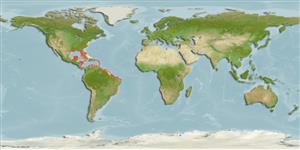Common names from other countries
Environment: milieu / climate zone / depth range / distribution range
Ecología
marino asociado a arrecife; rango de profundidad 30 - 70 m (Ref. 13608). Subtropical; 43°N - 33°S, 98°W - 34°W
Western Atlantic: Massachusetts, USA and Bermuda through the Gulf of Mexico to Brazil. Most abundant member of the genus Haemulon along the eastern coast of Florida (Ref. 26938).
Length at first maturity / Tamaño / Peso / Age
Maturity: Lm 14.0 range ? - ? cm
Max length : 28.0 cm TL macho / no sexado; (Ref. 11824); common length : 18.0 cm TL macho / no sexado; (Ref. 5217); peso máximo publicado: 85.60 g (Ref. 118626)
Espinas dorsales (total) : 13; Radios blandos dorsales (total) : 15; Espinas anales: 3; Radios blandos anales: 9. Silvery white with a mid-lateral yellow stripe running from eye to a large round black spot at base of caudal fin; a second narrower yellow stripe on back above lateral line (Ref. 13442).
Maximum depth from Ref. 126840. Inhabits seagrass beds, sand flats, and patch reefs (Ref. 9710). Forms schools (Ref. 5521). Feeds on small crustaceans, mollusks, other benthic invertebrates, plankton, and algae (Ref. 3798). Marketed fresh and salted (Ref. 3798).
Oviparous, distinct pairing during breeding (Ref. 205).
Robins, C.R. and G.C. Ray, 1986. A field guide to Atlantic coast fishes of North America. Houghton Mifflin Company, Boston, U.S.A. 354 p. (Ref. 7251)
IUCN Red List Status (Ref. 130435)
CITES (Ref. 128078)
Not Evaluated
Threat to humans
Reports of ciguatera poisoning (Ref. 30303)
Human uses
Pesquerías: escaso valor comercial; Acuario: Acuarios públicos; carnada: usually
Herramientas
Special reports
Download XML
Fuentes de Internet
Estimates based on models
Preferred temperature (Ref.
115969): 23.3 - 28.1, mean 27.2 (based on 912 cells).
Phylogenetic diversity index (Ref.
82804): PD
50 = 0.5000 [Uniqueness, from 0.5 = low to 2.0 = high].
Bayesian length-weight: a=0.01479 (0.01247 - 0.01755), b=2.99 (2.95 - 3.03), in cm Total Length, based on LWR estimates for this species (Ref.
93245).
Nivel trófico (Ref.
69278): 4.4 ±0.0 se; based on diet studies.
Resiliencia (Ref.
120179): Medio, población duplicada en un tiempo mínimo de 1.4-4.4 años (K=0.18-0.35; tmax=9; Fec=29,000).
Fishing Vulnerability (Ref.
59153): Moderate to high vulnerability (50 of 100).
